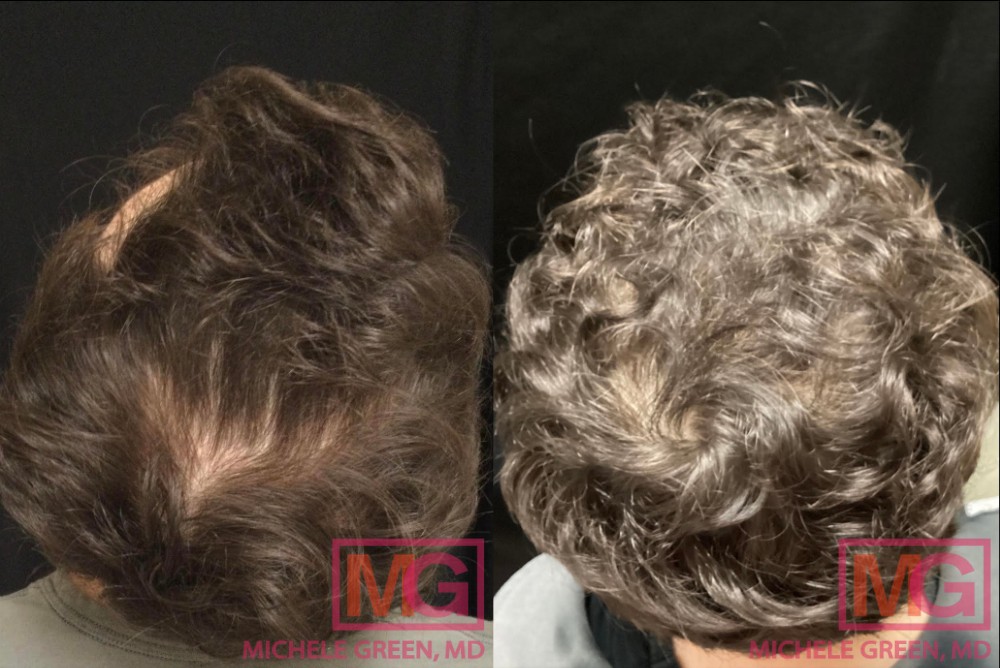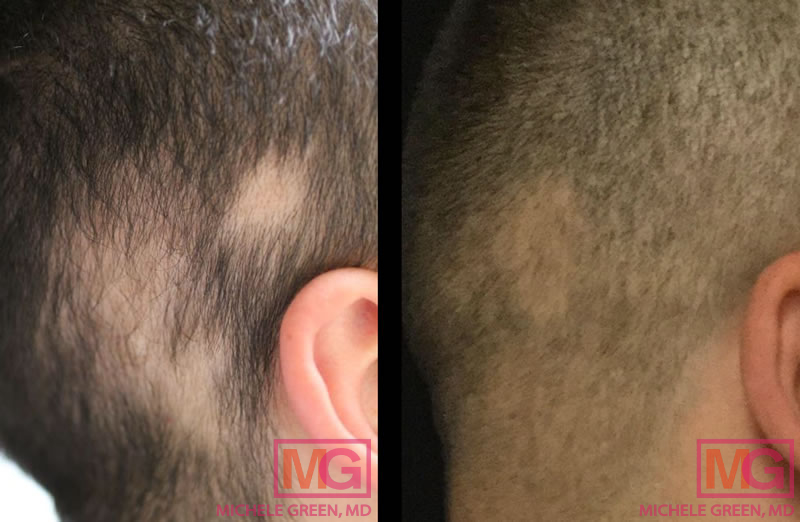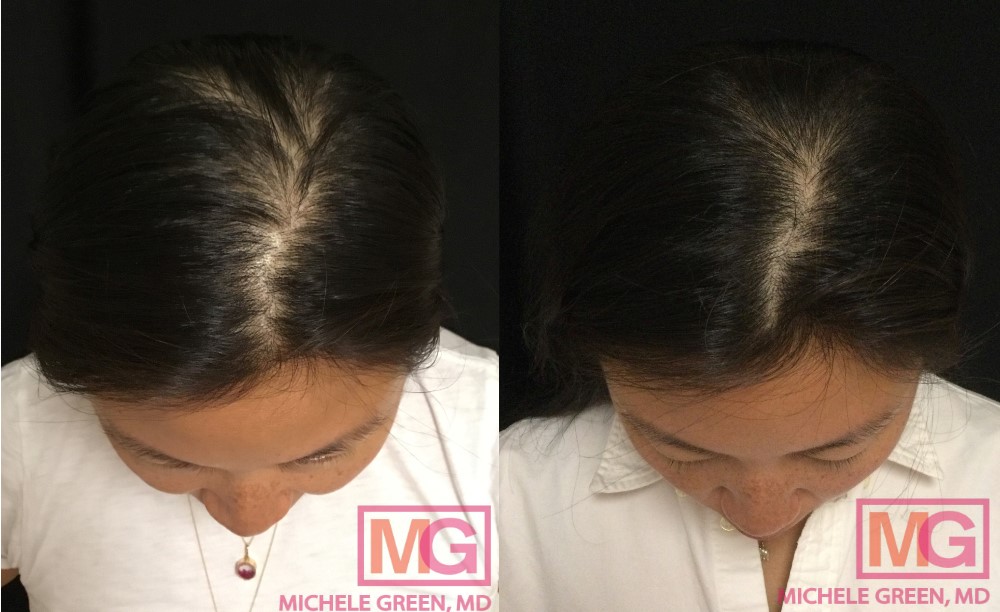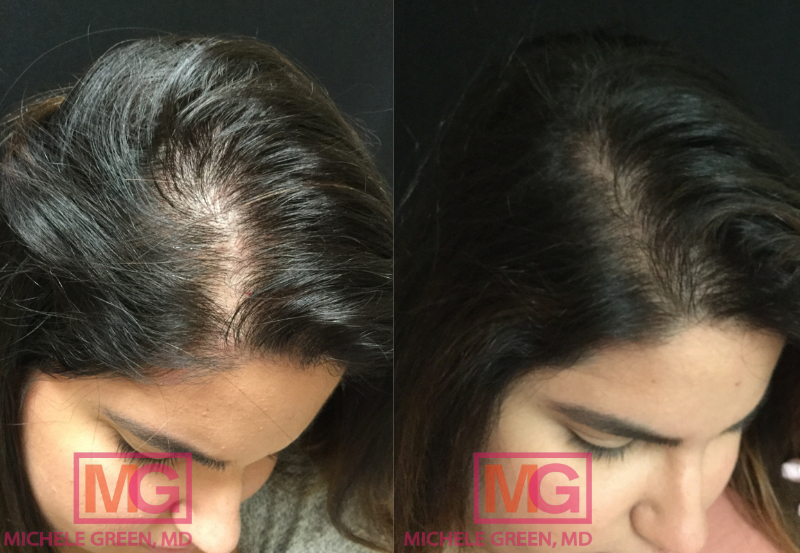Oral Minoxidil for Hair Loss
Hair loss conditions can be very distressing for the many patients who experience hair disorders throughout their lifetime. There are many reasons why hair loss or thinning may occur, ranging from female or male patterned baldness – also known as androgenetic alopecia, – hair loss as a result of shock or trauma, auto-immune disorders, or other genetic conditions. According to a study published in PubMed, androgenetic alopecia alone can affect up to 80% of men and 50% of women throughout their lives, which equates to approximately 50 million American men and 30 million American women each year. Hair loss treatment can feel difficult to navigate as there seem to be many options available, but how do you know which ones will really work? That is why it is best to begin by consulting with a board-certified dermatologist, Dr. Michele Green in NYC, who can provide you with a safe and effective treatment plan, potentially containing such prescription medications such as oral Minoxidil for hair loss.
Historically prescribed for high blood pressure and hypertension, researchers discovered that a side effect of high dose Minoxidil was that it promoted hair growth. As a result, scientists discovered that in lower doses, oral Minoxidil can be used to effectively strengthen hair follicles for increased hair retention and growth, thereby treating hair loss conditions. A newer, off-label alternative to topical Minoxidil, oral Minoxidil is convenient as it is usually easier to swallow a pill than apply medication onto the scalp, it does not leave any residue on the hair, it can be taken in conjunction with other treatments, such as finasteride, and it is typically less expensive than the topical formulation. As such, oral Minoxidil has become a popular option for hair loss treatment that works longterm. To begin your treatment with oral Minoxidil, the first step will be to make an appointment with Dr. Green.
Dr. Michele Green is an experienced, board-certified dermatologist who has been expertly treating a wide range of patients in her New York City Upper East Side office for more than 25 years. Dr. Green offers a wide variety of treatments in her office, including treatment for medical conditions such as alopecia and cosmetic treatments, including Botox, dermal fillers, laser treatments, chemical peels, and much more. Well known for patient satisfaction, Dr. Green has been voted one of New York City’s best heath care providers by Castle Connolly, New York Magazine and Super Doctors.

What is Oral Minoxidil?
Minoxidil is a medication that was created to be prescribed for hypertension and high blood pressure that was found to have positive effects when it comes to hair growth. When taken for hypertension, Minoxidil is typically dosed at 5 to 40mg, however, when dermatologists discovered the link between the drug and increased hair growth, a new form of Minoxidil was developed with a much lower dosage, typically between 0.25 and 5mg. When Minoxidil was first developed for dermatological use, it was only available in a topical form, known by the brand name Rogaine. However, recently a new, low dosage form of oral Minoxidil has been developed to combat hair loss from a variety of conditions, including androgenetic alopecia, telogen effluvium, and alopecia areata. Oral Minoxidil works well for patients who experience rashes or allergic contact dermatitis as a result of the topical Minoxidil. Patients can now take the drug by mouth for thicker, stronger hair.
How does Oral Minoxidil work?
Though oral Minoxidil treatment has been available for some time now, there is still a lack of complete understanding in the scientific community about how exactly oral Minoxidil works for hair restoration and strengthening. Several studies that have been recently published in the journal of the American Academy of Dermatology (J Am Acad Dermatol), have been examining the effects of low-dose oral Minoxidil treatment. Researchers, such as Sharma et al, have found that the Minoxidil drug promotes increased blood flow and oxygen supply to the hair follicle, thereby strengthening the hair follicle and promoting growth. Additionally, Minoxidil may cause hair follicles to spend less time in the resting phase of hair growth, called the telegen phase, and more time in the growth phase, or anagen phase. Some researchers suggest that Minoxidil can help to regulate the immune system, leading to the suppression of the T-cells responsible for autoimmune- related hair loss conditions.
What is low-dose oral Minoxidil used to treat?
There are several baldness conditions and hair disorders that can be addressed with the use of low-dose oral Minoxidil. Most commonly, researchers have studied oral Minoxidil when it comes to its use to combat androgenetic alopecia, though the drug has also been reportedly used to address other hair disorders, including telogen effluvium, alopecia areata, and loose anlagen syndrome.
Androgenetic Alopecia – Androgenetic alopecia is a condition that causes baldness in both men and women as a result of high levels of the androgen hormones. Androgen hormones can lead to the growth of weak and short strands of hair as well as a shortened anagen, or hair growth phase. As a result, the hair begins to thin and fall out. For men, male androgenetic alopecia typically manifests in the thinning of hair first near the temples, creating an “M” shape along the hairline. Hair can also begin to thin at the crown of the head. For women, androgenetic alopecia often manifests in a thinning of the hair along the part. Usually, it will look as though the part is expanding. According to researchers Randolph and Tosti (doi: 10.1016/j.jaad.2020.06.1009), Androgenetic alopecia is the condition that has been studied the thoroughly with regards to the use of oral Minoxidil and treatment of female pattern hair loss and male pattern baldness is possible with oral Minoxidil. In a systematic review of the use of oral Minoxidil to treat Androgenetic alopecia, Sharma, et al (Sharma AN, et al. Int J Dermatol) found that between 61 and 100% of patients experienced some improvement from the condition.
Telogen Effluvium – Telogen Effluvium is a hair condition in which hair shedding occurs as a result of a stress or trauma experienced by the patient. When a significant, stressful event occurs, the body responds by pushing hairs from the anagen growing phase into the telogen resting phase of hair growth. Typically, hair spends 2-6 years in the growing phase before proceeding to the resting phase, after which the hair falls out. The growing and resting phase for hair is staggered, however, when a stressful event causes hair to prematurely enter the telogen phase, approximately 2 months later all of that hair will enter the shedding phase. After a “shock,” up to 70% of the hair follicles can enter the shedding phase at once, which can cause the patient significant distress. While it is typically for hair regrowth to occur 2 to 6 months following the hair shedding, oral Minoxidil can help to promote and speed up new hair growth as well as better hair volume and thickness.

Alopecia Areata – Alopecia areata is caused by autoimmune disfunction, which leads to hair loss. The condition occurs when the white blood cells in body attack the hair follicles, causing the production of hair to decrease and the follicle to weaken. Often, the hair shedding occurs in small patches and will grow back within a year. The condition differs from telogen effluvium in that alopecia areata is genetic, rather than being caused by stress. As the condition often comes on quickly and without warning, it is difficult to prevent, however, oral Minoxidil is a treatment option that has been shown to be effective at improving the condition. According to full text review done by Sharma et. al, 18-82.4% of alopecia areata patients studied showed signs of improvement with the consistent prescribing of oral Minoxidil.
Loose Anlagen Syndrome – Loose Anlagen Syndrome is typically a pediatric condition, meaning it is frequently noted in children, and is characterized by loose hair that can be pulled from the head with no discomfort. The cause of the condition is yet unknown but researchers suspect that the syndrome is genetic. Oral Minoxidil can be used to strengthen the hair follicle to improved the hair texture and retention in low doses for children and adults.
How long does Oral Minoxidil take to work?
It takes several months of taking Oral Minoxidil as prescribed before the full effects of the treatment become visible. In fact, it can take anywhere between 6 and 12 months for the treatment to become fully effective. It is important to follow your provider’s prescribing directions when taking the medication because consistency in taking the medication is key in getting the best results. Throughout the first couple months of treatment, your dermatologist will monitor your progress on the drug and determine whether or not the dosage requires adjustment.
How long for Oral Minoxidil to work?
Oral Minoxidil is a long lasting solution for hair loss conditions, such as androgenetic alopecia, telogen effluvium, and alopecia areata, as long as you continue to take the medication. At the low dosage, oral Minoxidil can be taken long-term in order to maintain the hair strengthening results. As such, patients should expect to be prescribed oral Minoxidil for as long as they want to see the effects of the treatment. For patients who are gradually experiencing hair loss, such as patients with androgenetic alopecia, Oral Minoxidil will not completely prevent hair loss from occurring but can dramatically slow down the thinning process by strengthening the hair follicles for thicker, more rapidly growing hair.

Is Oral Minoxidil safe?
Researchers have more recently started extensively studying the effects Oral Minoxidil when it is used to treat hair loss conditions and have begun to demonstrate that oral Minoxidil is a safe and effective treatment. When starting oral Minoxidil for hair disorders, it is important to begin at a low dose. A low dose of the medication can help to strengthen and thicken the hair without the increased potential of adverse effects that can be associated with a higher dosage. The first step for addressing hair loss is to consult with a dermatologist who can help to determine the treatment plan that will be best for you. There are many treatment options, including oral Minoxidil, the topical formulation of Minoxidil, which can often be paired with finasteride. When you have your initial consultation with board-certified dermatologist, Dr. Michele Green, she will examine the treatment area and make a determination on the treatment, or series of treatments, that will best fit your needs.
What are the side effects of Oral Minoxidil?
There are several potential side effects that can develop as a result of taking oral Minoxidil. At higher doses, there is a higher risk of adverse effects such as postural hypotension, which is when there is a sudden drop in blood pressure occurs when you sit or stand up quickly, pedal edema, which is when fluid retention in the feet causes the feet and ankles to swell, tachycardia, which is defined as an elevated heart rate outside of strenuous activity, and, in more serious cases, angina, which is when low blood flow to the heart leads to chest pain and potential heart failure.
While the effects listed above are more likely to occur at higher doses of oral Minoxidil, there are some common side effects that can occur even at lower doses that do not typically cause patients to stop use of the medication. The largest review of the side effects of oral Minoxidil was performed by Vaño-Galvan et al in 2021. Vaño-Galvan reported that the most common side effect was hypertrichosis, which is defined as excessive hair growth. The researchers found that hypertrichosis can occur in 10-25% of patients who take oral Minoxidil at low doses and up to 50% of patients who take the medication at a higher dosage. Hypertrichosis typically did not stop patients from taking the medication since most were easily able to engage in easy hair removal treatments, such as shaving. As Minoxidil is typically prescribed to treat high blood pressure, patients taking Minoxidil in any dosage may experience low blood pressure and, as a result, lightheadedness. Another very common side effect of oral Minoxidil is temporary hair shedding, which can occur when patients first begin taking the medication. This side effect will usually subside after 4 weeks and in order to get the best results, it is imperative that patients continue to take the medication as directed.
Does oral Minoxidil cause shedding?
Patients will sometimes ask, can oral Minoxidil cause hair loss, and the answer is sometimes but only temporarily. One of the common side effects of oral Minoxidil is an initial shedding of the hair during the first six weeks of treatment. This hair shedding is only temporary, lasting generally for four weeks, and will resolve itself after that short period of time. It is very important that patients continue to take the medication during this time in order to gain the full helpful effects of the treatment. It can take up to a year for the full effects of the treatment to become visible but after that time, the medication can help to provide patients with thicker, fuller, stronger hair as long as they continue to take it.
Is oral Minoxidil more effective than topical?
Topical Minoxidil has been used for many years to treat hair disorders. The topical formulation is applied to the scalp regularly in order to prevent excess shedding and strengthen the hair. When applied topically, the enzymes in the hair follicle root will perform sulfotransferase, which changes Minoxidil into its active form of minoxidil sulfate. Sometimes, however, these enzymes are not present on the scalp but can be found in the liver. As such, these patients will not respond to the topical Minoxidil treatment but may respond to oral treatment. Another reason that patients may prefer oral Minoxidil to topical Minoxidil is that topical Minoxidil can affect the hair, making it greasy, and irritating the scalp. This can lead patients not to comply with the prescription of the medication. Oral minoxidil does not affect the scalp in that way, making it an easier and more appealing option for many patients. It is also often easier to swallow a pill than to apply a solution to the scalp.

Can you use oral and topical Minoxidil together?
Topical Minoxidil and Oral Minoxidil should not be used together. Typically, a dermatologist may begin by prescribing topical Minoxidil and then may switch the prescription to oral Minoxidil if the topical formulation is not proving to be effective or is irritating the scalp. Oral Minoxidil can be combined with finasteride, which is a medication that can be taken specifically to combat male patterned baldness. The drug helps to inhibit the body’s changing of testosterone into dihydrotestosterone, which is a hormone that can harm the hair follicles. With less dihydrotestosterone present in the scalp, there is a lower chance of the harm to the hair follicles.
Is oral Minoxidil better than topical?
Both oral Minoxidil and topical Minoxidil are safe and effective treatments for a variety of hair loss conditions. One treatment is not necessarily inherently “better” than the other, it is about finding the treatment plan that will work best for you. When you have your initial consultation with Dr. Green, you can discuss your condition and the treatment area to determine which treatment or series of treatments will work best for you. Be sure to disclose to Dr. Green is you have any drug allergies or a history of heart issues and angina, which might be a contraindication for oral Minoxidil.
Is oral Minoxidil FDA approved?
Oral Minoxidil for hair loss is still considered an off-label use of the medication, meaning it has not yet been FDA approved. While some studies and retrospectives have been done on the effectiveness of the drug in low doses for preventing hair loss, oral Minoxidil has not gone through clinical trials for hair conditions. Though oral Minoxidil is not yet FDA approved to treat hair disorders, it has been shown to be safe and effective as a long-term solution to conditions including androgenetic alopecia. Topical Minoxidil, however, has been FDA approved in 1988 to treat hair conditions for men and 1991 to treat hair conditions for women.
How to get started with Oral Minoxidil today?
For many people hair is a defining feature, which is why hair loss disorders can be so distressing. Hair conditions can come in many forms from the genetic androgenetic alopecia condition that affect both men and women, the auto-immune disorder alopecia areata, loose anlagen syndrome, and the stress or trauma based telogen effluvium. If you are dealing with any of those conditions, oral Minoxidil may be the best solution for you. The medication results in thicker, healthier hair follicles, which leads to more volume and less hair loss. The best place to start is by consulting with a board-certified dermatologist, such as Dr. Michele Green. Please contact us online or call 212-535-3088 to learn more about how oral minoxidil can treat your hair disorder.
Please note: Due to NY state laws, Patient Consultations can only be done in person.
 212-535-3088
212-535-3088